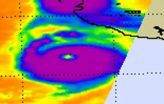The second piece by Sam Schabacker, a senior organizer for the consumer advocacy organization, Food & Water Watch, paints a different picture. In it, hydraulic fracturing – a process that injects sand, water and chemicals into deep shale formations to extract natural gas – is a water-guzzler. It's a poisonous process that pumps toxic chemicals into the ground, contaminating water and air, and harming people, wildlife and agriculture along the way.
The two drastically differing views cut to the heart of an increasingly polarized debate about hydraulic fracturing, also known as fracing. While fracing has been used since the 1950s, debate about the controversial process has escalated in recent years as oil and gas companies have expanded their operations into "shale plays," geologically tight formations containing vast natural gas resources. Recent documentaries like "Gasland" and "Haynesville" have further heightened public interest in fracturing, and earlier this summer Texas lawmakers passed groundbreaking legislation requiring oil and gas operators to publicly disclose the specific chemicals used during the extraction process.
But behind the scenes of this typically oversimplified issue are experts – experts like those at The University of Texas at Austin and the Cockrell School of Engineering. Their innovative and interdisciplinary research is helping to improve the safety and efficiency of hydraulic fracturing, identify issues that need to be corrected and untangle the knowns and unknowns of a process that is expected to constitute perhaps half of the nation's total natural gas supplies in coming years.
Along the way, the researchers are adding important science and policy-based contributions to the national dialogue.
Research to improve the process
Fracing creates fractures in shale formations and extracts natural gas by injecting wells with sand, water and chemicals. Thanks to the ability to drill wells horizontally, the process has transformed traditionally unproductive deep shale formations and over the past decade it, along with two other forms of unconventional gas, has increased the nation's domestic energy production by 30-40 percent.
"They've added the equivalent of about 3 million barrels of oil production per day to the U.S. To give context, we only produce about 7 million barrels of oil per day here," said Mukul Sharma, a professor in the Petroleum and Geosystems Engineering Department, who is internationally regarded for his expertise on hydraulic fracturing. "You can't think of any technology that has done that in the last 50 years or more."
But some say this energy gain is not without serious costs, and concerns about environmental impacts have spurred France, the state of New Jersey and – up until recently – New York, to ban the practice altogether.
Among the myriad of concerns expressed about the process is that it contaminates groundwater, causes earthquakes and leaks chemicals like methane and benzene into the air.
To date, oil and gas regulators and other experts in groundwater protection have found little evidence of a direct link between fracing and groundwater contamination, but no comprehensive study of the technology has been conducted.
Danny Reible, a professor in the Civil, Architectural and Environmental Engineering Department, who recently lent his groundwater expertise to the Environmental Protection Agency for a fracing study the agency plans to conduct, said contamination could occur as a result of poor well design and construction, or bad waste management at the surface level.
Because gas, salt and sand stick to water during the extraction process it comes out murky and salty – making it difficult to reuse. Most commonly in the Marcellus Shale, which spans the northeastern United States and is ground zero for the fracturing controversy, water leftover from fracturing is treated at the surface, often in ill-prepared publicly owned treatment works instead of recycled or disposed of underground with injection wells as it is in much of the US
In order to reduce the risks of fracturing and to alleviate concerns about the process, Reible and faculty say two things must happen: first, well operators must strictly adhere to industry best practices and, secondly, a concerted effort must be made to reuse or reinject water at more wells or improve surface treatment.
Nowhere than at the Cockrell School of Engineering is there a more innovative and collective effort to help enable the latter.
Chemical engineering Professor Benny Freeman and a doctoral student created technology that binds to water membranes and makes them more resistant to sticking – thus overcoming the greatest hurdle to water reuse. Other engineering faculty, like Sharma, are also researching ways to eliminate water's use altogether. The researchers built software that allows well operators to design simulated fractures in which gas and oil are extracted by injecting CO2, nitrogen, liquid foam, or others types of fluids, instead of water.
"It's the only simulator of its kind in the world. Nobody else has this capability," Sharma said.
Deciphering facts and myths
Sharma has researched hydraulic fracturing for 25 years, but he's never seen as much attention focused on the issue as there is now. Tad Patzek.
That's why, earlier this summer, he hosted a presentation and question-and-answer session about hydraulic fracturing that was open to students, faculty and invited members of the media. The goal of the presentation was to provide a better understanding of the concerns – both real and perceived – about hydraulic fracturing.
"I think we need to be doing more of this high-level discussion," he said. "If not, documentaries come out and the public is misinformed."
One by one, Sharma addressed a range of statements about fracturing: The process causes earthquakes. (Yes, Sharma told those at the presentation, but their magnitude is smaller than an earthquake that occurs when a truck drives down a road, rarely producing any damage to buildings on the surface.) The process is water-intensive. (Sharma said municipal water-use in the Barnett Shale — a top natural gas-producing formation in north Texas — is 323 billion gallons. Water used for fracturing in the same area is only about 2.7 million gallons per well.)
And so on.
But the difficulty with hydraulic fracturing – and with nailing down its facts and myths – is that more research is needed to either substantiate or refute allegations that it harms the environment.
No comprehensive study of the technology has been conducted, though entities such as Congress, the Environmental Protection Agency and the Department of Energy, among others, have initiated studies about the practice and its effects.
The groups will also be joined by the Energy Institute at The University of Texas at Austin, which announced this summer that it will lead a-first-of-its-kind, comprehensive review of the science, policy and environmental issues surrounding fracturing.
The project will combine an independent assessment of alleged groundwater contamination, air emissions and seismic events attributed to fracturing with a detailed analysis of the scope and effectiveness of laws and regulations related to the process.
"We're trying to take inventory of as many claims as possible attributed to shale gas development and then run them down. Which have been investigated, and what happened? Was it a casing failure or was it fracturing itself?," said Chip Groat, a geology professor and associate director of the Energy Institute. "For people to say there are no effects of shale gas development is incorrect, but we want to see what really caused these things and not have the old knee-jerk reaction that says, 'Oh its fracing.'"
Groat said the goal of the study is to promote a fact-based approach to regulatory policies for shale gas development.
Cockrell School faculty will provide technical guidance on the study, which includes faculty from the University's Bureau of Economic Geology, LBJ School of Public Affairs, School of Law, Center for International Energy and Environmental Policy, and College of Communication. Scott Tinker.
Engineering faculty are also working with a team of university energy scientists and economists to conduct the first detailed, comprehensive assessment of the amount of shale gas in place, the amount that can be recovered and the likely production rates in the U.S.
Questions about the productivity of natural gas wells and the size of their reserves have come under fire recently, due largely in part to an article in the New York Times.
Scott Tinker, director of the Bureau of Economic Geology at the Jackson School of Geosciences and principal investigator of the study, said there is a large natural gas resource base, but the political and regulatory framework must be favorable in order to develop technologies that more efficiently extract the gas.
Tinker said the study aims to provide policy makers with broad guidelines regarding the surface infrastructure and water handling needs to develop the resource.
Educating the public
Talk to any university expert about hydraulic fracturing, and no one can say with certainty what's in store for its future.
"I think if anyone tells you right now that they know where this is going, you know not to believe them," Tinker said.
But engineering and university faculty are at the forefront of developing technology and policy recommendations to help ensure that natural gas is extracted with as few risks as possible. They are also working to educate the public about fracturing and to correct misinformation about the science surrounding it.
Tad Patzek, chair of the Cockrell School's Petroleum and Geosystems Engineering Department, said the controversy surrounding fracturing is part of a bigger discussion that must take place about the realities of society's growing energy demands, and our ability to meet them. Tad Patzek.
The energy landscape is changing, he said. As more constraints are placed on energy supplies, oil and gas companies will be forced to move from rural places – like the empty plains of West Texas portrayed in "Giant" – and into areas where people live in order to produce energy.
"If we assume we want to continue our current way of life, we will need energy," said Patzek, who is also conducting research on unconventional gas recovery. "And quite unfortunately, it will now come from the places we continue to live, so we're going to have to learn how to co-exist"
INFORMATION:
END


